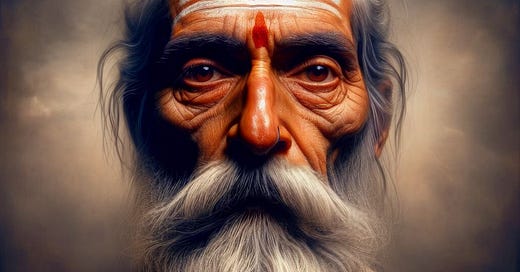The Sacred Topknot of the Rishis. A Symbol of Spiritual Aspiration in Vedanta Tradition.
How the Śikhā Represents the Connection between the Human and the Divine.
In the ancient spiritual tradition of India, the mystic topknot hairstyle of the rishis carried profound symbolic meaning. The venerated rishis were sages and seers believed to have authored the Vedic hymns and possessed immense spiritual wisdom. Their distinctive hairstyle and appearance reflected core tenets of Vedanta philosophy and signalled their singular focus on self-realization.
As wandering ascetics, rishis wore their hair long and twisted into matted locks called 'jata.' They would pile their jata hair high on their head and bind it securely into a topknot, or Shikha. In Sanskrit, Shikha means "crest" or "peak", evoking a summit of spiritual mastery. The regal, imposing topknot conveyed the rishi's nobility of purpose in pursuing moksha, or liberation from the cycle of rebirth.
Read My Novella: Shankara's Bhaja Govindam - Chronicle of an Abduction in Varanasi.
When I first read about the life and teachings of Adi Shankara, I was struck by how much spiritual wisdom and insight this 8th-century philosopher possessed. Shankara revived and reinterpreted the ancient philosophy of Advaita Vedanta, teaching radical ideas of non-duality and the illusion of separateness. His verses known as the Bhaja Govindam inspire …
By rejecting worldly comforts and material entanglements, rishis demonstrated their sole aim of moving toward enlightenment. Their unshorn, knotted hair visibly marked their separation from common society. Vedanta emphasizes detachment from illusion and developing transcendental awareness to uncover the true self within. The rishi's symbolic topknot visually expressed his inner-directed focus and unwavering striving toward self-realization.
In Vedic scriptures, hair is considered an extension of one's nervous system and subtle body. Hair is seen as a conduit for divine energy from the infinite cosmos. The longer the hair, the more rays of spiritual light can flow into the mind and consciousness. When rolled into a topknot, the coiled hair was believed to stimulate and retain this sacred spiritual energy.
The knot also channels energy upward to invoke heightened states of awareness. In yoga, the top of the head is associated with the crown chakra, the seat of intuition and direct connection to the Divine. By binding their long braids, rishis activated this portal for communion with pure consciousness. The raised topknot advertises the rishi's ongoing union with eternal truths.
When unbound, the rishi's tresses falling freely signalled his descent from heightened meditation and infusion of divine insight. After releasing their topknots, rishis would then share revelations, chant Vedic hymns, and disseminate spiritual knowledge among students. So the topknot reflects their cyclic spiritual practice - ascension to the heights of enlightenment and return to humanity laden with wisdom.
In Vedanta philosophy, the state of absolute oneness underlies all multiplicity. The individual self and universal self are held to be ultimately identical when illusion falls away. For rishis, the round shape of their topknot symbolizes the unified wholeness accessible through spiritual discipline. Vedanta teaches that enlightenment cannot be isolated - it must be integrated into lived experience.
Likewise, the rishi's knot both anchors his realized selfhood and radiates wisdom into the world. The topknot visually ties together the rishi's transcendent nature and human form, serving as an emblem of his integrated enlightenment.
Rishis demonstrate that spiritual liberation does not make one aloof, but generates compassion. Their role is to guide others toward moksha through Vedic teachings. This ministry of service is imprinted in the towering mark of the rishi's topknot.
So in Vedanta philosophy, the rishi's unshorn hair bound high in a topknot carries profound layers of significance. The ritual topknot signals the rishi's commitment to spiritual seekers and the single-minded pursuit of moksha. It invokes energies to heighten awareness and ultimately unite the self with the Divine. And it continually reminds the rishi of his duty to share transcendental truths for the liberation of all beings.
"The topknot is the symbol of the sun, the source of light and life. The top knot is also the symbol of the highest knowledge, the knowledge of Brahman. He who wears the topknot with this understanding attains the supreme light and life, and the supreme knowledge."
Chandogya Upanishad 3.16.1
"The topknot is the sign of a renunciant, who has given up all worldly attachments and desires. The topknot is also the sign of a yogi, who has mastered the control of the vital breaths and the mind. He who wears the topknot with this intention achieves liberation from the cycle of birth and death."
Maitri Upanishad 6.35
I have woven tales to share, for any who care to read them. My books await you on Google Books. Check also my stories on Medium.com.
I would be honoured if you considered subscribing to the Premium Contents of my Vedanta Substack and leaving feedback, comments, and suggestions both on this page and by writing to me at cosmicdancerpodcast@gmail.com.
Thank you for your precious attention.





